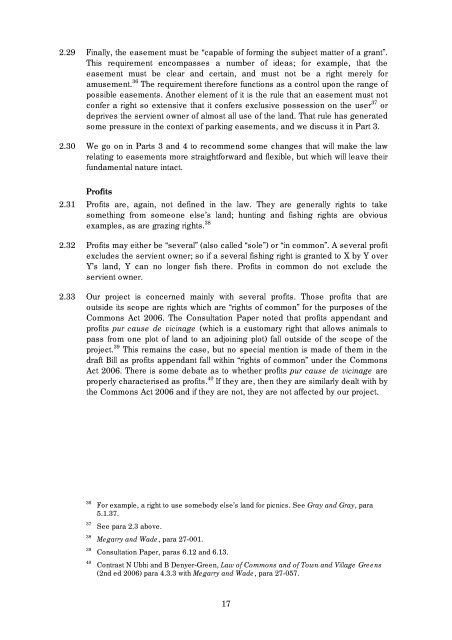Making Land Work: Easements, Covenants and ... - Law Commission
Making Land Work: Easements, Covenants and ... - Law Commission
Making Land Work: Easements, Covenants and ... - Law Commission
Create successful ePaper yourself
Turn your PDF publications into a flip-book with our unique Google optimized e-Paper software.
2.29 Finally, the easement must be “capable of forming the subject matter of a grant”.<br />
This requirement encompasses a number of ideas; for example, that the<br />
easement must be clear <strong>and</strong> certain, <strong>and</strong> must not be a right merely for<br />
amusement. 36 The requirement therefore functions as a control upon the range of<br />
possible easements. Another element of it is the rule that an easement must not<br />
confer a right so extensive that it confers exclusive possession on the user 37 or<br />
deprives the servient owner of almost all use of the l<strong>and</strong>. That rule has generated<br />
some pressure in the context of parking easements, <strong>and</strong> we discuss it in Part 3.<br />
2.30 We go on in Parts 3 <strong>and</strong> 4 to recommend some changes that will make the law<br />
relating to easements more straightforward <strong>and</strong> flexible, but which will leave their<br />
fundamental nature intact.<br />
Profits<br />
2.31 Profits are, again, not defined in the law. They are generally rights to take<br />
something from someone else’s l<strong>and</strong>; hunting <strong>and</strong> fishing rights are obvious<br />
examples, as are grazing rights. 38<br />
2.32 Profits may either be “several” (also called “sole”) or “in common”. A several profit<br />
excludes the servient owner; so if a several fishing right is granted to X by Y over<br />
Y’s l<strong>and</strong>, Y can no longer fish there. Profits in common do not exclude the<br />
servient owner.<br />
2.33 Our project is concerned mainly with several profits. Those profits that are<br />
outside its scope are rights which are “rights of common” for the purposes of the<br />
Commons Act 2006. The Consultation Paper noted that profits appendant <strong>and</strong><br />
profits pur cause de vicinage (which is a customary right that allows animals to<br />
pass from one plot of l<strong>and</strong> to an adjoining plot) fall outside of the scope of the<br />
project. 39 This remains the case, but no special mention is made of them in the<br />
draft Bill as profits appendant fall within “rights of common” under the Commons<br />
Act 2006. There is some debate as to whether profits pur cause de vicinage are<br />
properly characterised as profits. 40 If they are, then they are similarly dealt with by<br />
the Commons Act 2006 <strong>and</strong> if they are not, they are not affected by our project.<br />
36<br />
For example, a right to use somebody else’s l<strong>and</strong> for picnics. See Gray <strong>and</strong> Gray, para<br />
5.1.37.<br />
37 See para 2.3 above.<br />
38 Megarry <strong>and</strong> Wade, para 27-001.<br />
39 Consultation Paper, paras 6.12 <strong>and</strong> 6.13.<br />
40 Contrast N Ubhi <strong>and</strong> B Denyer-Green, <strong>Law</strong> of Commons <strong>and</strong> of Town <strong>and</strong> Village Greens<br />
(2nd ed 2006) para 4.3.3 with Megarry <strong>and</strong> Wade, para 27-057.<br />
17
















